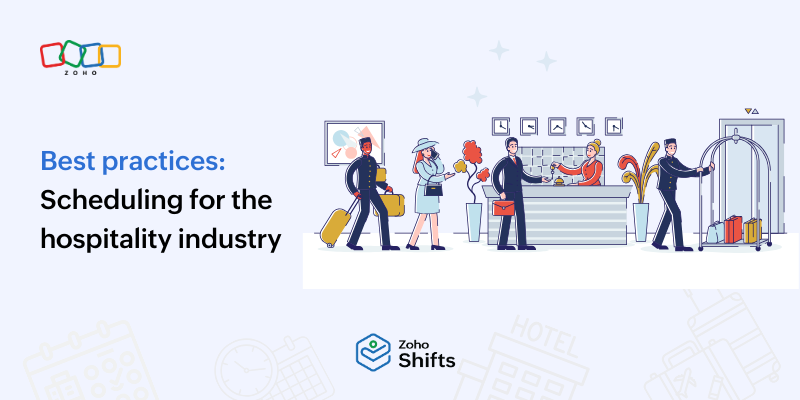- HOME
- Industry Resources
- Employee scheduling for seasonal demand fluctuations in retail industries
Employee scheduling for seasonal demand fluctuations in retail industries
- Last Updated : November 23, 2023
- 619 Views
- 6 Min Read

Managing a retail business can be quite a juggling act, from keeping up with ever-changing customer wants, dealing with fierce competition, navigating supply chain hiccups, and the occasional "Where's my staff?" moment.
And then there's the dreaded task of scheduling your employees. Whether you've got 10 or 1,000, juggling their availability, making a schedule that's precise and fair—well, it's enough to make you wish for a tropical getaway!
Okay, let's not just talk about how boring employee scheduling is. According to a 2023 report by WebinarCare, the average employer spends 0.63% of their workweek on employee scheduling. Though this may seem small, it adds up to over two hours per week for a company with 100 employees.
Also, 68% of employee work schedules are handwritten. This manual process is time-consuming and error-prone, and it can lead to a number of problems, such as:
Missed shifts
Overtime costs
Employee dissatisfaction
Reduced productivity
And to make matters even spicier, holiday seasons hit retail industries like a storm with a sudden surge in customers.
In this blog post, we've got your back with the best practices, coolest tips, and tricks to help you craft employee schedules that handle those wild holiday season shifts in the retail industry with precision and fairness.
What is retail scheduling?
Retail scheduling is a process of creating a weekly schedule or rota that assigns shifts to all of the employees in a retail store. It’s a critical task in retail operations because it affects both the business and the employees.

Retail scheduling should be done in a way that ensures that the store has enough staff on hand to meet customer demand, but also that employees are not over-scheduled. It’s also important to consider the needs of the employees, such as their availability, preferences, and work-life balance.
Why is employee scheduling important in the retail industry?
Well, it's crucial for several reasons. First, it ensures that you have enough staff to meet customer demands, especially during peak hours or holiday seasons.
Second, it helps in cutting down labor costs by scheduling employees efficiently, avoiding overstaffing during slow times and understaffing during busy periods. So, by creating an employee scheduling solution for your retail store, you can improve your operations in the following ways.
Improve customer service
When there are enough employees on staff to meet customer demand, customers are less likely to have to wait in long lines or go without help. This can lead to a more positive customer experience and increased sales.
Reduce labor costs
Employee scheduling can help retailers reduce labor costs by ensuring that the right number of employees are on staff at the right time. This can be done by taking into account factors such as customer demand, employee availability, and labor laws.
Increase employee satisfaction
When employees have a fair and predictable schedule, they’re more likely to be satisfied with their job. This can lead to reduced turnover and increased productivity.
Improve operational efficiency
By carefully scheduling employees, retailers can ensure that all tasks are covered and that the store is running smoothly. This can lead to increased efficiency and profitability.
Now, let's see employee scheduling in action through the story of "Holiday Haven," a bustling retail store, during the holiday season.
Managing peak seasons and fluctuating customer demands in the retail industry
Situated in the heart of a bustling town, Holiday Haven, a retail store, was a beloved destination for holiday shoppers seeking that perfect gift, festive decorations, or simply a taste of the seasonal spirit.

As the holiday season set in, for the dedicated team at Holiday Haven it meant more than just the promise of brisk sales. It also presented an annual challenge—managing the soaring demand while ensuring that the staff could cope with the avalanche of customers that would soon descend upon the store.
This was where the magic of employee scheduling came into play. In the back rooms of Holiday Haven, a small team worked on a plan that would make or break the season.
So here's how employee scheduling transformed Holiday Haven into a wonderland of commerce, where both shoppers and employees found themselves wrapped in the warmth of efficiency and holiday cheer.
Identifying peak hours and seasons
Their journey began by analyzing past records and trends. They knew when the tides of customers would surge, whether it was during Black Friday's early morning frenzy or the last-minute rush on Christmas Eve. Armed with this data, they crafted a schedule that was both a shield against the onslaught of customers and a beacon of support for their employees.
Scheduling experienced and skilled staff
Among the pages of the schedule, they reserved the best for the busiest times. Experienced cashiers adept at swift transactions, seasoned stockers who could navigate the storage with ease, and skilled sales associates who could guide customers to find the perfect gifts—all were assigned their roles during peak hours.
The result was a symphony of talent, ensuring that customers received not only what they sought but also the warm, competent service they deserved.
Utilizing flexible scheduling
However, Holiday Haven knew that despite their best efforts, the season could still bring surprises. That's where flexible scheduling came into play. Employees were given the freedom to swap shifts when needed, and some chose to work extra hours during the bustling days. Part-time and seasonal hires joined the team, bolstering their ranks during the most demanding stretches.
Harnessing employee scheduling software
To weave all of these elements together seamlessly, they used retail scheduling software like Zoho Shifts.

This allowed them to not only create schedules efficiently but also to track employee availability, skills, and preferences. Budgets were carefully considered, ensuring that they met both operational needs and financial constraints.
Effective communication
The schedule was not just a document; it was a lifeline. Holiday Haven ensured that employees were informed well in advance, allowing them to make necessary arrangements for their festive season commitments. This open line of communication fostered goodwill among the staff, keeping spirits high.
Adaptability and continuous monitoring
Holiday retail can be unpredictable, and the schedule was designed with adaptability in mind. If a sudden surge in customers occurred, the team was ready to call in additional staff. They monitored the schedule like a weather vane, making adjustments as needed to avoid overstaffing during quieter periods.
Coordinating staff schedules across multiple locations
Centralized scheduling, powered by sophisticated employee scheduling software, seamlessly harmonized various locations, shifts, and departments. Effective communication, flexibility, data-informed decisions, and proactive planning were the keynotes in this orchestration, ensuring that every Holiday Haven store operated like a well-tuned symphony during the bustling holiday season.

The result was a retail performance that resonated with both customers and staff, creating a festive shopping experience filled with warmth and cheer.
Tips and tricks to implement fairness in employee scheduling
Fairness was the guiding principle in Holiday Haven's scheduling symphony. To ensure equity among employees, they employed several tips and tricks.
1. Fair distribution of hours
Schedules were meticulously crafted to ensure that all employees received a fair share of hours, avoiding situations where some were consistently burdened with long shifts while others struggled to secure enough work.
2. Transparency
The schedules were shared openly, and employees were encouraged to communicate any concerns or preferences. This transparency allowed for adjustments that accommodated individual needs, fostering goodwill and trust.
3. Equal opportunity for desired shifts
To avoid favoritism, employees were given equal opportunities to request preferred shifts or time off. This created a level playing field and made it easier to accommodate their needs while adhering to the law.
4. Predictive scheduling to prevent time theft
In the spirit of fairness and in compliance with labor laws, Holiday Haven implemented predictive scheduling. This involved providing employees with advance notice of their schedules, usually two weeks in advance. This practice prevented time theft and ensured that employees could plan their personal lives alongside work commitments.
5. FLSA compliance
To ensure adherence to the Fair Labor Standards Act (FLSA), Holiday Haven maintained accurate records of hours worked, breaks, and overtime. They paid close attention to the classification of employees to determine eligibility for overtime, thus avoiding potential legal issues and maintaining the financial health of the business.
With these practices, fairness reigned at Holiday Haven. Employees felt valued, confident, and well-informed about their work schedules, and the store maintained compliance with labor laws, preventing time theft and fostering a harmonious work environment. This commitment to fairness, time management, and legal compliance ensured that the holiday retail magic at Holiday Haven was not just enchanting for customers but also fair and equitable for its dedicated employees.
Wrapping up
Employee scheduling is a critical aspect of managing a successful retail business, especially during seasonal demand fluctuations. As demonstrated by the story of "Holiday Haven," effective scheduling can transform a chaotic holiday season into a well-orchestrated shopping experience that benefits both customers and employees.
By identifying peak hours, scheduling experienced staff, embracing flexibility, and utilizing advanced scheduling software, retailers can navigate the challenges of holiday retail with grace.
Additionally, implementing fairness in scheduling through transparent practices and compliance with labor laws ensures that employees feel valued and respected. In the ever-competitive retail industry, mastering the art of employee scheduling is key to enhancing customer satisfaction, reducing costs, and fostering a harmonious work environment.
So, whether you're managing a small boutique or a large retail chain, remember that a well-crafted schedule can make all the difference during the holiday rush.


